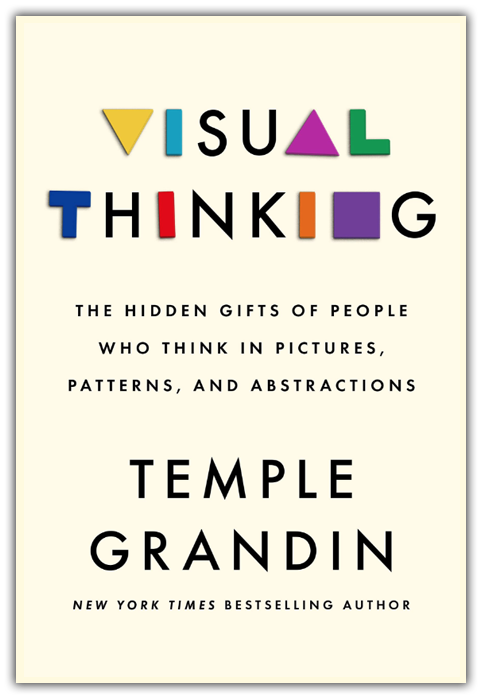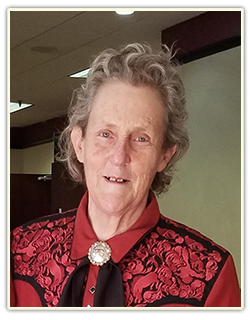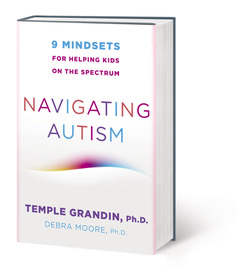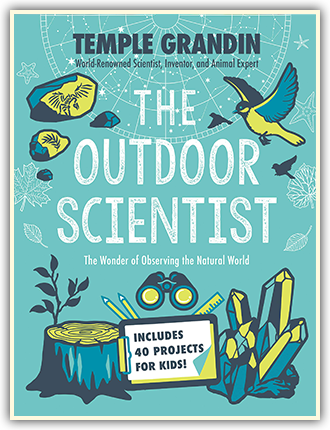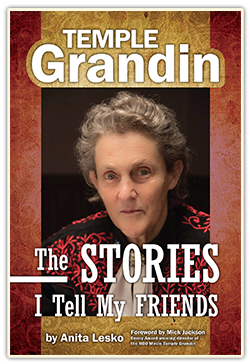
ASK TEMPLE!
Click "Ask Temple" to submit a question and it will be sent to Temple! She will answer as many as she can.
Webinars & Conferences
Upcoming Conferences
March 27 - Harrisonburg, VA
April 9 - Webinar
May 6 - Webinar
New Book!
Visual Thinking
A MUST LISTEN!!
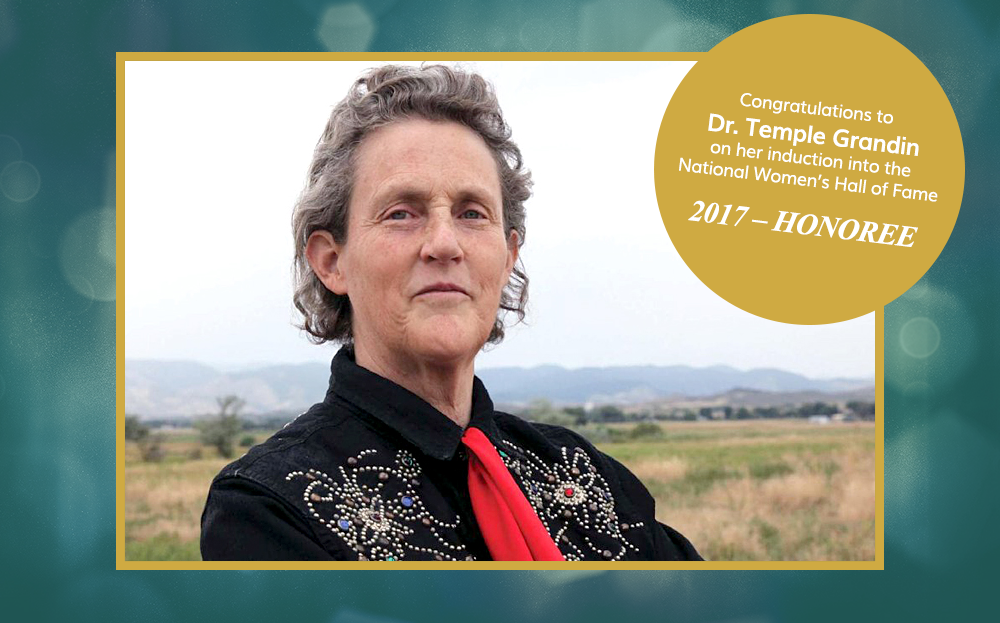
Congratulations to Temple and her induction into the American Academy of Arts and Sciences!
Click here and below to watch!
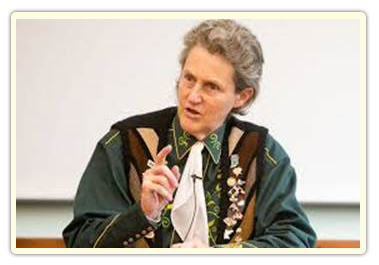
Temple Grandin earns Dole Leadership Prize!
NAVIGATING AUTISM
"The Outdoor Scientist"
Brand new book now available!
Brand new edition of Temple Grandin's "Unwrittern Rules of Social Relationships" now available!
A Candid View of a Fascinating Life
Frequently Asked Questions
ANSWERS TO AUTISTIC ADVOCATES QUESTIONS ABOUT:
IDENTITY, ABA, AND CURING AUTISM
By Temple Grandin - March, 2022
I have been receiving more questions about my position on subjects ranging from identify first versus person first language, Applied Behavior Analysis (ABA) and other terminology. Advocates who are on the autism spectrum prefer the term “autistic” because it is their identity. Many teachers and educators prefer the term “person with autism.” My first book used identity first language and the title was Emergence Labeled Autistic. It was published in 1986. The initial path I chose was to have an interesting career. This gave my life purpose. Today I want to help both young and older autistic individuals get fulfilling jobs. I get asked all the time how I got interested in being in the cattle industry. I was exposed to it when I visited my aunt’s ranch. This is why it is so important to expose kids to many different things that could turn into careers.
I have been receiving more questions about my position on subjects ranging from identify first versus person first language, Applied Behavior Analysis (ABA) and other terminology. Advocates who are on the autism spectrum prefer the term “autistic” because it is their identity. Many teachers and educators prefer the term “person with autism.” My first book used identity first language and the title was Emergence Labeled Autistic. It was published in 1986. The initial path I chose was to have an interesting career. This gave my life purpose. Today I want to help both young and older autistic individuals get fulfilling jobs. I get asked all the time how I got interested in being in the cattle industry. I was exposed to it when I visited my aunt’s ranch. This is why it is so important to expose kids to many different things that could turn into careers.
During my career, I have worked with many colleagues who were autistic but not officially diagnosed. They were welders, machinery designers, and drafting professionals. Some of the best times in my life have been with friends who had the same shared interest, such as horses, when I was a teenager and discussions with people in the shop on how to build things. I always got along really well with the person who was different who worked in the shop. I want kids on the spectrum to have the opportunity to find a career they will love. I have worked with many undiagnosed autistic people who loved their jobs in a skilled trade, computer programming or being a professor. For older people, receiving a diagnosis is often a relief because it explains their problems with relationships. Autistic individuals have written their own stories and in my book Different Not Less.
Autism Terminology
In my more recent lectures and the most recent edition of The Way I See It, I no longer use the terms “high functioning” and “low functioning” autism. For autistic children over age six, I use the terms “verbal and “non-verbal.” I have also made a point of telling parents, therapists, and teachers about books that were written by non-verbal individuals who are able to type completely independently. These autistic individuals describe sensory overload, sensory scrambling, and problems with controlling their movements. These books are must reads for parents, therapists, and teachers who work with individuals who remain non-verbal. The titles are Carley’s Voice, How Can I Talk if my Lips Don’t Move, The Reason I Jump, and Fall Down 7 Times, Get up 8.
Answers to Questions About Applied Behavior Analysis (ABA)
There are two rigid forms of ABA that are really bad. In the first type, the child or adult is forced into sensory overload. This can be really painful. Unfortunately, there are still some poor programs where the practitioners do not believe that sensory problems exist. By observing many teachers working with young two- to five-year-old children, I have learned that effective teachers, regardless of who employs them, all do similar things. They know how to engage the children. I define a teacher of small two- to four-year-old children as effective if the child progresses.
1. The child should like going to therapy. If the child hates therapy, the teacher may be causing sensory overload.
2. Learns more speech and becomes more socially engaged.
3. Learns how to wait and take turns at games.
4. Learns more skills, such as dressing.
The second type of poor ABA is forcing rigid compliance that stifles an older child’s creativity. If a child is fixated on cars, then that interest should be broadened and used as a motivator for teaching reading and math. A common mistake with AB A is not phasing it out in an older child or adult who no longer needs it. ABA was originally developed to be a little kid’s program to get them ready for regular school. My advice to parents and therapists is to emphasize the importance of early education of very young two- and three-year-old children. The Denver Start Model, Ayres Sensory Integration, augmentative and alternative communication and Behavioral Momentum are also evidence-based programs. In Behavioral Momentum, the therapist starts with an easy task the child wants to do and then they progress to tasks you want the child to do. ABA is not the only effective program. It is one tool in the toolbox. The best ABA programs are flexible and will use a variety of approaches.
Position on Video Games
If video games had been available when I was a small child, I would have been a total addict. One time I thought I had played a video game for 30 minutes and I had played it for several hours. Research clearly shows that individuals on the autism spectrum are more likely to become addicted to video games. Mother restricted TV watching to one hour a day on weekdays and two hours a day on weekends. During my travel to conferences and discussion at virtual conferences, I have observed two pathways for fully verbal autistic adults. They either end up playing video games all day or they are out working. I have seen many individuals really “blossom” when they got out and did more things. If the young adults were going into wonderful careers in the video game industry, I would not be critical. Unfortunately, that is not happening. I do not believe in banning video games but their use should be limited. Limited use of multiplayer games where players can talk to each other can provide friendships. For an autistic adult who plays video games all day, there may be opportunities to replace them with something else. Three young adults were introduced to auto mechanics and they found that it was more interesting than video games. I am not advocating auto mechanics for everybody, but these were three successful examples.
Issue of Curing Autism
I like the logical way that I think and I do not want to be cured. I have been criticized because many years ago I made a statement that “In an ideal world, the scientist should find a method to prevent the most severe forms of autism but allow milder forms to survive.” Advocates on the spectrum have accused me of favoring eugenics. I am totally against eugenics. I am in favor of methods that may reduce severity such as providing adequate vitamins to pregnant mothers. Andre Sourander and his colleagues in Finland found that vitamin D deficiency during pregnancy greatly increased the risk of autism. Autism is associated with hundreds of different brain development genes and if it was eliminated, there would be no future EInsteins, Elon Musks, or Michelangelos. Autism is a true continuous trait and in its mildest forms, it would be a personality variant. Some people are more interested in social emotional relationships and others are more interested in their careers or favorite subjects. Research is showing that it is possible to detect possible early signs of autism in very young infants. They are less like to be interested in looking at people. Training parents to socially engaged their babies, using the Denver Start Method, may reduce symptom severity. This model emphasizes play, social, and language skills. There is also exciting new research on the beneficial effects of extremely early intervention where parents are trained to socially engaged with their babies.
Swedish researcher Nicolo Caporale and colleagues tested the blood of pregnant women. They discovered that blood containing mixtures of three chemicals increased the chances of having a child with speech delay. The chemicals were phthalates, bisphenol A and trielosan. Mixtures of these chemicals were more likely to cause problems compared to a single chemical. These chemicals are used in thermal paper receipts, food packaging, antibacterial, and some cosmetics. Based on this information, one way to reduce risk is to avoid paper credit receipts.
Sensory over sensitivity and becoming overwhelmed by sensory overload are major problems for some autistic individuals. It is my opinion that finding effective treatments for sensory problems should be a major research priority. When I was a tiny baby, I stiffened and did not want to be touched. Anecdotal evidence indicates that carrying the very young baby around for several hours a day in a commercially available strap-on baby carrier may reduce touch sensitivity. Deep pressure and vestibular stimulation from hours of being carried may be helpful. These carriers are available in every Wal-Mart. They might help reduce future touch sensory problems. Reducing the pain and confusion from overwhelming sensory input would greatly improve lives.
Another easy to do intervention is called Environmental Enrichment. This is also an evidence based treatment. Each day, a child is gently stimulated with a combination of sensory inputs such as smelling a variety of pleasant odors, combined with deep pressure. The principle is to always keep changing the stimuli and to always stimulate two different senses at the same time. This is enjoyable therapy that may reduce sensory problems and improve behavior.
Further Reading
Bhattacharjee, Y. (2020) Finding early signs of autism, National Geographic, pp. 90-91.
Bowles, N. (2018) A dark consensus about screens and kids begins to emerge in Silicon Valley, New York Times, October 26, 2018.
Fuller, E.A. and Kaiser, A.P. (2020) The effects of early intervention on social communication outcomes for children with autism spectrum disorder: A meta-analysis, Journal of Autism and Developmental Disorders, 50(5):1683-1700.
Fuller, E.A. et al. (2020) The effect of the Denver Start Model for children with autism spectrum disorder: A meta-analysis, Brain Sciences, MDPI.
Hume, K. et al. (2021) Evidence based practices of children, youth, and young adults with autism: Third Generation Review, Journal of Autism and Developmental Disorders.
Newman, J. (2020) Coming of age with autism, National Geographic, pp. 66-85.
Schoen, S.A. et al. (2018) systematic review of Ayres Sensory Integration intervention for children with autism, Autism Research, 12(1):6-19.
Sourander, A. et al. (2021) Maternal Vitamin D levels during pregnancy and offspring spectrum disorder, Biological Psychiatry, 90(11):790-797.
Woo, C.C. et al. (2015) Environmental enrichment as a therapy for autism: A clinical trial replication and extension Behavior Neuroscience Vol. 129, pp. 412-422.
Woo, C.C. and Leon, M. (2013) Environmental enrichment as an effective treatment for autism: A randomized controlled trial, Behavior Neuroscience, DOI:10.1037/10033010.
Liew, Z. and Guo, P. (2022) Human health effects of chemical mixtures, Child Development can be adversely affected by endocrine disrupting chemicals, Science 375 (658) pp. 720-721.
PACING
Many people on the autism spectrum have the need to stem. This can be done in a form of hand flapping, outbursts or pacing. Sometimes giving the person a fidget device to hold in their hands will help keep them occupied. Getting lots of exercise can lessen the urge to pace. The best approach is to try and reduce pacing when it is a real distraction for other people. Always give them a place where pacing is OK.
WHERE DO THEY GO?
In the movie, my character, Claire Danes, asks the question "Where do they go?" people ask me if I have found out "where they go" since that time. Here is my answer:
That is one of life's great questions. When I think about it, I get motivated to life a life that will make a positive difference.
YOU DON'T HAVE TO BE PERFECT
Many kids today get really upset if they are not able to do a task perfectly. I think part of this problem is due to many schools removing hands-on activities such as art, woodworking, sewing, and cooking. When you do practical things, perfection is much more difficult. If you make a mistake, then you need to figure out how to correct it. Another problem today is kids do not do enough activities where they just have to figure something out. When I was a child, I spent hours experimenting to make a little bird kite fly. In my book Calling All Minds, there are lots of hands-on projects where children will need to figure out how to do something.
Another thing I had to learn is that I could not always be the first in line or the first to play at a game. From a young age, I was taught the importance of turn taking when playing games. When our family played a board game and I started to make a move before my sister’s turn, my mother would quietly tell me that I had to wait until it was my turn. Another thing I was taught was not to be a sore loser and a poor sport. When I was in elementary school, there was a s simple rule that my mother enforced. If I had a tantrum when I lost a game or was not able to go first, she took TV away for one night. The rule was the same at home and school. She never took TV away if the tantrum was due to noise sensitivity. She recognized that meltdowns caused by sensory overload was not something I could control. Parents and teachers should never take away things such as art supplies, music or anything else that can be used to develop a child’s skills. The way she enforced the rule was very calm. I would go to my room and scream and after I had completely calmed down she would invite me back to join the family. She would then say, “You know the rule. There will be no TV tonight.” I had to learn that throwing a fit would not enable me to always get my way. If this strategy is going to be effective, an improvement in behavior should occur within a few weeks. My temper tantrums in my elementary years were reduced to one or two every few months. It is essential that enforcement of the rule is consistent at both home and school.
One word of warning. Most of the above recommendations are for fully verbal children. Not being able to communicate is a huge frustration and can lead to meltdowns and tantrums. The child must be given a way to communicate. I can remember the frustration of not being able to talk. In Emergence Labeled Autistic, a tantrum is described when I did not want to wear a hat. When I did not know how to talk, screaming was one of the only ways to tell people I did not want to do something. A non-verbal child must be given an alternative method to communicate so they do not have to resort to screaming.
ACADEMICS
Children on the Spectrum often have uneven skills. I have talked to parents of many children who are brilliant in Math and poor in Reading. If a third grader is capable of doing high school Math, he should be provided with the advanced books. If he is forced to do baby Math, he will become a behavior problem.
Since kids on the spectrum often have uneven skills he may need special education in Reading.
Children who had advanced skills should be doing advanced work so they can develop their ability. It is also important to teach the importance of helping others. A child with advanced skills will help teach and tutor other children. Never hold a smart child back!
TEACHERS AND AUTISM STUDENTS
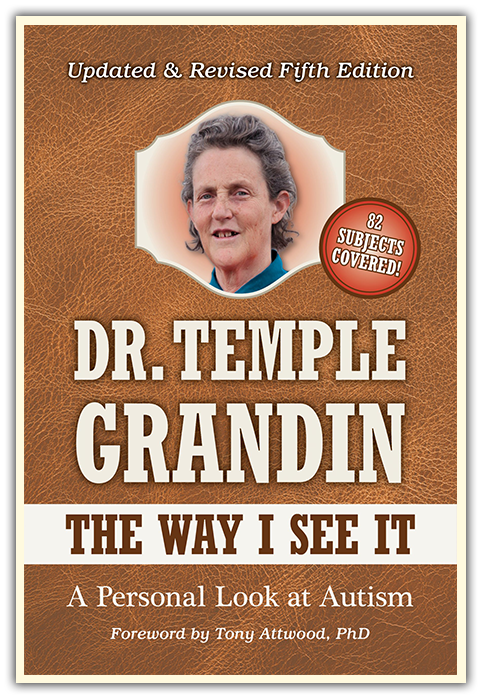 Many children with autism and other developmental disorders will have problems with sensory over sensitivity. They may have difficulty when the classroom becomes noisy and confusing. Some children cannot tolerate florescent lights because they can see flickers like a flashing strobe light. I recommend reading the sensory section in my book The Way I See It. When a child with autism becomes over stimulated, he/she may need to take a break away from the noise in a quiet location.
Many children with autism and other developmental disorders will have problems with sensory over sensitivity. They may have difficulty when the classroom becomes noisy and confusing. Some children cannot tolerate florescent lights because they can see flickers like a flashing strobe light. I recommend reading the sensory section in my book The Way I See It. When a child with autism becomes over stimulated, he/she may need to take a break away from the noise in a quiet location.
Children with autism do not pick up social cues from other people. They need to be instructed on how to behave. The best way to do this is to take advantage of natural “teachable moments.” For example, if a child with autism fails to wait for his/her turn during an activity, do not yell “No.” Instead, calmly give the instruction on what the child should do. Tell him/her, “Wait until Jim has taken his turn.”
Some children with autism get too close and crowd another child’s space. If this occurs, give the instruction. Tell him/her “Jimmy does not like it when you get so close and you keep touching him.” It may be a good idea to teach the child with autism how to do the High five hand clap with another child. You will need to demonstrate how to do high fives, and then he/she can greet other children in a socially appropriate way. He/She will also need to be taught how often it is appropriate to do high fives. Doing it ten times is not appropriate.
Every social interaction has to be taught. If the autistic child is bothering the other children by telling them some story about dinosaurs 20 times, you should tell him/her that he/she should tell that story no more than twice. When I was little and I forgot to say “please” mother would stop me and say, “you forgot to say please.” I would usually say it before she got to the word “please.”
The Social Stories books by Carol Gray may be helpful. This is a system where the child is given written scripts on how to behave in different situations.
Children on the autism spectrum often have problems with remembering long strings of verbal instruction. If the child has good reading skills, give him/her written instructions. When a task requires a sequence of steps to perform a task provide the child with a pilot’s checklist. For each step write one to three keywords to trigger their memory.
Vague instructions do not work with children with autism. For example, give the child an exact date that the homework is due. Be patient if the child asks lots of questions because he/she dot not understand exactly what the assignment is. Children on the autism spectrum need specific detailed instructions so that they understand the assignment.
ANXIETY
During my 20’s, I had increasingly severe anxiety and panic attacks. Hard exercise and physical work helped. For me, the only thing that really stopped the panic attacks was a low dose of antidepressants. Low doses are essential to prevent side effects such as insomnia and agitation. Many people have found Prozac to be effective. I recommend reading the medical sections in Thinking in Pictures and The Way I See It.
CHORES
Yes. Doing chores teaches elementary school children important skills on doing work for others. When I was 13, I had my first job two afternoons a week. Below are all the work experiences that I had before I graduated from college. Learning work skills is extremely important and work experiences should start in middle school. Today good work experiences for teenagers could be: walking dogs, fixing computers, mowing lawns, making PowerPoint presentations, making greeting cards and selling them, or writing for a church or community newsletter. They need to do tasks that other people will value. Volunteer work counts as work.
My Teenage Work Experience
-
13 years of age – Hand-sewed hems and took apart garments two afternoons a week for a freelance seamstress.
-
15-years of age - Took care of nine horses. I cleaned their stalls and fed them.
-
16 years of age – Worked on my aunt’s ranch building a gate that could be opened from a car and other projects.
-
In college, I interned one summer in a research laboratory.
- Transition to Work
Ideally, the transition to work should be accomplished before a student with autism graduates from high school. This can start with volunteer jobs at a church or community center when the child is 10 to 11 years old. It is important to learn how to perform tasks for other people outside the home. These tasks should be on a regular schedule. Children in middle school should learn how to shop and do a neighborhood job such as walking dogs. When the child reaches the legal working age of 14 to 16, he/she should get a real summer job. Parents need to use their contacts to get an employer to “try out” their child without forcing them to do an interview.
It is never too late to start with an older student or adult with no work experience. Make the transition gradual. Sudden surprises frighten. Give the individual a choice between two different jobs. At first, the job may be only one or two hours a day. The hours should be gradually increased.
DELAYED SPEECH AND TEACHING YOUNG CHILDREN
You need to start working with your child now. Many scientific studies show that early educational intervention improves a child’s prognosis. The earlier the teaching starts, the better. The worst thing you can do with a young autistic child is nothing. Letting your child watch TV all day is really bad. If no services are available, you need to get volunteers to work with your child. Grandmothers and college students majoring in education are good sources of volunteers. Use the social networks you have in your church, synagogue, mosque, or community group to locate people. Some people have the ability to work with children with autism and others do not. A young child with autism should have a minimum of 20 hours per week engaged in one to one teaching. An effective teacher will be able to achieve more language, better turn taking skills, and better social interaction. The child’s brain needs to be kept engaged with the world.
Suggestions for Teaching
-
Teach your child words. When you give him/her a snack, name the food when you give it to him/her. For example, say “apple” when you give your child an apple.
-
Play lots of games that involve turn taking. If the child is spinning a penny, turn it into a game of taking turns. Children’s board games, such as Candyland, are good for teaching turn taking. When a child gets older, use board games that are suitable for an older child.
-
Limit TV and video game playing to one hour per day.
-
Sing nursery rhymes and play other interactive children’s games. Always try to encourage social interaction and eye contact.
-
Use lots of positive reinforcement, smiling and praise. Encourage the child to give you a smile.
-
Use each mealtime to teach social interaction and manners. Structured meals where a child learns social skills are part of a 20-hour week program.
-
Make sure your child gets plenty of exercise. Exercise has a calming effect. Cut excess sugar out of their diet. Make sure he/she has a good breakfast that contains lots of protein such as meat, eggs, dairy or peanut butter. Sugar loaded foods such as Pop tarts or powered sugar donuts are bad. Eating protein, especially at breakfast, really helps one to be calmer, focused, and less likely to get headaches.
-
Always provide opportunities for the child to use language. When you know your child wants something ask he/she to use their words. Allow plenty of time for the child the respond. Some children have a slow processing speed and five to ten seconds may be required.
- Talk slowly and enunciate the hard consonant sounds. When I was three adults talking fast sounded like gibberish. My speech teacher would alternate back and forth between saying the word slowly and saying it at normal speed.
DIETARY RESTRICTIONS
In my twenties I had severe colitis attacks and sometimes I had to eat yogurt and Jell-O for a week to get over the colitis. When the colitis got better, I gradually switched back to regular food. In my early thirties, I started taking a low dose of anti-depressants to control my anxiety and panic attacks. The medication greatly helped my anxiety and it also cured my colitis. The colitis was caused by my body being in a constant state of stress. For further information, read the chapter "A Believer in Biochemistry" in Thinking in Pictures.
PICKY EATERS
I am very concerned that some children with very limited diets may have vitamin deficiencies. The first step is to give him/her a multiple vitamin. Parents should work closely with their pediatrician or other health professional. To encourage eating more variety, try putting a small amount of a new food next to the child’s favorite food. Tell him/her they have to try the new food first. Some children do not want to try new things because it is new. You can let your child touch, explore, and play with the new food in the kitchen. Never allow food playing the dining room because it is bad manners. Do it in the kitchen. Other tips for the child that will only eat certain take out, fast food, or snack food is to try putting a similar homemade food in the same package.
BIOMEDICAL TREATMENTS
The most important biomedical treatments to try are the special diets. They are most likely to help children who have gastrointestinal problems. They do not work for everybody. A special diet does not cure autism, but in some children, there may be definite improvements. Parents have reported improvements such as more language, less hyperactivity, and fewer tantrums. I am going to provide a basic overview of diets that can be easily implemented by buying regular food. It does not have to be organic. All fresh fruits and vegetables should be washed before eating. For families on a budget, it is possible to do special diets with economical foods. I have found that greatly reducing the amount of wheat in my diet has helped reduce skin rashes and eczema. There are three basic types of special diets. A child should always take a good multivitamin.
-
Gluten-free – Wheat is the most important item to remove. Most breads, cakes, and cookies contain wheat. Labels on processed food need to be read carefully to make sure all the gluten is removed. If the diet is going to work, results should become obvious in three months. Sometimes when a child first goes gluten-free, there will be a period where her/his behavior will get worse before it gets better. For example, a gluten-free diet can be done easily with economical foods such as rice, hamburger, fresh fruits, nuts, vegetables, beans, potatoes, and dairy products. Rice cakes, rice noodles, cornbread, corn chips, and corn tortillas can be used as economical bread substitutes.
-
Dairy/casein-free – In this diet, all dairy products and foods containing derivatives of dairy such as casein, are removed. Foods in the dairy class include cheese, milk, yogurt, ice cream, and cottage cheese. If a dairy-free diet is doing to be beneficial, you should see results in one month. Some children who do not tolerate milk can eat plain yogurt that contains active yogurt cultures. I eat lots of Dannon plain yogurt. Some kids need to be off both gluten and dairy. For some children, soy milk is not recommended as a dairy substitute. Soy products may cause problems in some children.
-
Carbohydrates – All children will benefit if the amount of sugar they eat is limited. If I eat a high carbohydrate breakfast of a sugared cereal, I am dizzy and light headed by 10 AM. A good breakfast containing lots of protein prevents this. Eggs, sausage, and a piece of fresh fruit is what I eat for breakfast. It is better to eat whole fresh fruit instead of juice. This lowers the glycemic index. The specific carbohydrate diet is similar to an Atkins diet. Complex, starchy carbohydrates, such as potatoes, rice, and bread are removed. I have found that greatly reducing high glycemic carbs has helped me control yeast infections. Yeast infections often get worse if lots of sugar is consumed.
-
Other Biomedical Treatments – Some of the other biomedical treatments that have scientific backing are fish oil Omega 3 supplements, and B6 and magnesium. The American diet is deficient in Omega 3. Salmon is a good source of Omega 3 and I eat some every week. Some of the other supplements, such as amino acids, may be helpful. Try one thing at a time. Tyrosine has been shown to have a calming effect in ADHD. Be careful not to take too much. Too high a dose may have a bad effect. SHTP, the precursor of tryptophan may also be helpful. Tryptophan has been shown to have a calming effect on animals. Be very careful in individuals taking antidepressants or St. John’s Wort. Antidepressants, St. John’s Wort and SHTP all raise serotonin levels. If the serotonin levels get too high, the result is agitation and insomnia. If a child becomes agitated on these supplements, the dose is too high. The supplement should be stopped immediately. I have found that probiotics have helped me to control urinary tract and yeast infections. Plain Dannon yogurt has been helpful. There are many probiotic products on the market. The products that have worked best for me have high levels of lactobacillus acidophilus, and bifidobacterium lactis. Melatonin is often helpful as a sleep aid. One of my favorite books on biomedical treatments is Healing the New Childhood Epidemics by Kenneth Bock, M.D. (2007), Ballentine Book.
- In some children with autism, folic acid improved verbal communication. The dose was 50 mg. per day. It is a non-methylated form of folic acid. A major advantage is it can be given orally. (Frye et al 2016, molecular Psychiatry)
When I read a bunch of scientific literature on Omega 3’s there was mixed results for autism. For depression and bipolar disorders there are more studies with positive results. I speculate that fish oil supplements may be more effective in children or adults who have a deficient diet. When I was a child in the 1950’s everybody in our community ate fish on Friday’s. Children in my community were taught that fish was brain food. - To learn about scientific research you can search scientific literature on either Google Scholar or PubMed. Their data bases are easy to find. Type the names into Google.
UPDATE ON SUPPLEMENTAL RESEARCH:
- CBD Oil is a derivative of marijuana that does not make a person high. It is definitely effective for severe uncontrollable epileptic seizures. There is some evidence it may be helpful for both autism and ADHD. Children and teenagers should avoid taking forms of marijuana, if necessary, until their brains are fully developed. Further information can be easily obtained by using keywords “Autism” and “CBD OIL” on Google Scholar and PubMed.
UPDATE ON CBD OIL
CONCLUSIONS– Parents should work closely with their doctor or other health provider to monitor their child’s progress. Many supplements and conventional pharmaceuticals interact with each other. This is why it is so important to carefully try one thing at a time.
DISCIPLINE
I cannot emphasize the importance of consistency. When I was in elementary school, the penalty for having a tantrum was to have no TV for one night. That was the rule and it was always enforced. It is essential for the rules to be consistent at BOTH home and school. Parents and teachers must work together otherwise the child may manipulate the parent against the teacher and vice versa. Kids need to learn that “No” means No and be rewarded when they do things right. You also need to determine if a behavior problem is caused by pain or sensory over sensitivity. Hidden painful medical problems must be ruled out. Some common ones are – acid reflex (heartburn), constipation, yeast infections, toothaches, and earaches. A child may fear going into a room where a smoke alarm had previously gone off, because it hurt his/hear ears. After these biological causes of behavior problems are ruled out, then the behavioral motivation can be figured out.
The three main behavioral causes of tantrums and other problems behaviors are:
-
Get attention
-
Frustration because communication is difficult
-
Escape from a task
Each one of these motivators needs to be handled in a different way. Often the best way to handle behaviors motivated for attention getting is to ignore it. If a non-verbal child is frustrated because he/she cannot communicate, he/she should be given a means to communicate, such as a picture board or picture exchange. There are many new apps available for I Pads and other tablets for communication. If the child is trying to escape from a task, you need to make sure the task is not stupid. An example of a stupid task would be making a brilliant 8-year-old do baby math drills. He/she should be given the more advanced math book.
All children in the autism spectrum should be expected to do daily living tasks that they are capable of doing. Some examples are making their bed, being on time for the school bus or helping with household chores. When I was a child, I was expected to have good table manners and to say “please” and “thank you.” When I made a mistake with table manners, mother did not say No. She told me the correct behavior. For example if I ate mashed potatoes with my fingers, she said, “No, use your fork.” She gave me the instruction, instead of just saying NO.
FIXATIONS
Use the motivation of a fixation to motivate other activities. If trains are a child’s favorite thing, read a book about trains, do math with trains, and teach science with trains. Read about a place a train travels to, or calculate how long it takes a train to travel between two cities.
BUILDING WITH LEGOS, ETC.
Yes. Parents and teachers should strive to encourage a child’s creativity. When I was in elementary school, my mother always encouraged my ability In art. It is important to broaden out the talent. If I had been left alone, the only thing I would have drawn would have been horse heads. To expand your child’s ability, encourage making drawings of things that are related to a child’s fixation. I was encouraged to draw other things. Some examples would be the horse’s stable or a place you might ride a horse. He/she needs to learn how to do drawings that other people will want and appreciate.
Children who love Legos should graduate to using real wood working tools when they are 10 to 11 years old. There is a huge shortage of workers in highly skilled trades such as electronics, plumbing, auto mechanics and welding. Children who leard they like using tools may be good at these careers.
JOB INTERVIEWS
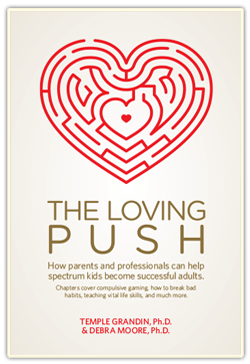 I never found work by filling out a job application and doing a normal interview. I found work by always having my portfolio with me and showing it off when the opportunity arose.
I never found work by filling out a job application and doing a normal interview. I found work by always having my portfolio with me and showing it off when the opportunity arose.
When I was in Graduate School I painted signs for local businesses and the carnival at the Arizona State Fair. When I went to the Fair I met a sign painter and showed him my portfolio. The next day I was painting signs on carnival attractions. I carried my portfolio of completed sign projects in a black notebook. Today, a person can carry it on their Smart Phone.
My next step was writing for a farm magazine. I had the guts to go up to people and show my work. Kids need to build confidence to do this. This is why Middle and High School are important. When I was a child I sold candy door to door for charity. This activity built confidence. My sign painting job led to selling cattle design projects; one small project at a time.
I sold my skills by showing a portfolio of photos, drawings and articles. I learned very early that the door to opportunity was showing my portfolio to the right person. The right person could be anywhere, such as a supermarket or a family party. Today with social networking, it may be even easier to get samples of your work out where people can see it.
MEDICATIONS
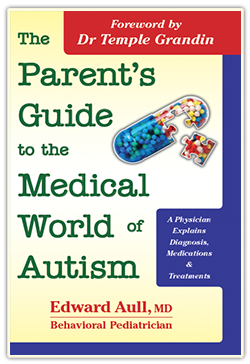 There are way too many powerful medications with severe side effects casually given out to young children. I am very concerned about possible long-term damage to the child’s developing nervous system. This is especially a concern when powerful antipsychotic drugs are given. They may cause tardive dykinesia,which may cause permanent Parkinson-like shaking. For more complete information on medications you will need to read the medication chapters in the 2006 edition of Thinking in Pictures and the 2014 4th Edition of The Way I See it. In young children, it is usually recommended to try interventions, such as special diets first, for treating behavior problems that are related to autism.
There are way too many powerful medications with severe side effects casually given out to young children. I am very concerned about possible long-term damage to the child’s developing nervous system. This is especially a concern when powerful antipsychotic drugs are given. They may cause tardive dykinesia,which may cause permanent Parkinson-like shaking. For more complete information on medications you will need to read the medication chapters in the 2006 edition of Thinking in Pictures and the 2014 4th Edition of The Way I See it. In young children, it is usually recommended to try interventions, such as special diets first, for treating behavior problems that are related to autism.
There are some older children and adults who will need conventional medication to control behavior. My anxiety and panic attacks were 90% eliminated with a low dose of antidepressants. Often a very low dose of a drug such as Prozac (fluoxetine) works for anxiety. If the dose is too high, it may cause agitation and insomnia. If agitation occurs, the dose must be immediately lowered. The correct dose of an antidepressant may be only ¼ to ½ the normal starter dose. Other medications that are useful for calming are blood pressure medications such as clonidine, beta blockers, such as propranolol and Minipres (prazosin). Antidepressants, blood pressure medications and the stimulants have less severe side effects compared to antipsychotics. However, there are some cases of severe aggressions where a low dose of antipsychotic such as risperdal (risperidone), Ambilify (aripiprazole) or Screquel (quetiapine) may be required in older children and adults.
**Of course, prescription drugs should be scripted by a physician that has examined the child and knows their medical history. A good journal article that is available as an open access paper is: Coleman et al (2019) Rating of the Effectiveness of 26 Psychiatric and Seizure Medications for Autism Spectrum Disorder. Journal of Child and Adolescent Psychiatry.
SENSITIVITIES
NOISE SENSITIVITIES
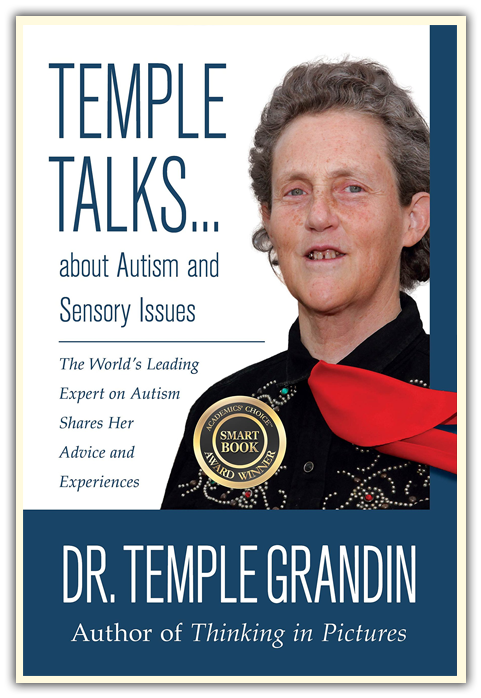 The child can wear headphones or earplugs when he/she goes in a noisy place. However, it is important to never wear the headphones or earplugs all day. This will make your child more sensitive to sound. The earphones or earplugs must be off for at least half the day.
The child can wear headphones or earplugs when he/she goes in a noisy place. However, it is important to never wear the headphones or earplugs all day. This will make your child more sensitive to sound. The earphones or earplugs must be off for at least half the day.
Children with autism, sensory processing disorders, ADHD and many other disorders, will tolerate loud sounds more easily if they initiate or have control of exposure to the sound. If a child cannot tolerate being in a noisy supermarket, let him/her control the amount of time spent in the supermarket. If he/she fears the smoke alarm, take an old smoke alarm and wrap it up in a towel and let the child turn it on. Gradually he/she may be able to tolerate it with less and less towels wrapped around it. Another approach is to put the dreaded sounds on a recording device. In some cases, this may not work because some electronic audio formats are compressed and do not provide a high fidelity recording. A very high fidelity recording is needed. If a high quality recording is available, the child can turn it on all by him/herself at gradually increasing volume. It is essential that the child has control.
Another simpler alternative is to let the child control and use a noise device such as a vacuum cleaner.
FLORESCENT OR LED LIGHTING SENSITIVITIES TO FLICKER
-
Move the child’s desk over by the window.
-
Provide the child with an old fashioned incandescent lamp.
-
Try different lamps and find some that do not flicker. Some cheaper LED lamps are bad.
-
Try colored overlays or printing homework and reading materials on pastel paper. Try grey, tan, light green, light blue, light pink, light yellow, and other pale colors.
-
Irlen colored lenses help many children and adults. The child or adult tries on many different pale colored lenses until the best color is found. Each person has to find the right color that works for them. For families on a budget, try different pale colored sunglasses at a local store. Often the color that often works best is pale lavender, pale tan, pale pink, and other pale colors. Experiment with different colors. The tints must be pale because reading with lenses that are too dark would cause eyestrain. If your school has a theater department, you could experiment with the gel papers that are put on colored theater lights. To find the right tint, try reading a book under florescent lights when you try on different colors. Small pieces of theater gel paper can be taped to old glasses frames. When the right color is found, a local optician could tint the lenses. Sometimes the color that works on the lens is different than the color that works on the child's paper. If you are not on a budget, I would recommend going to an Irlen provider who is skilled at helping people find the right color.
SLEEP HABITS
Try simple things first such as making sure your child gets lots of exercise and reducing sugar in the diet. Some children sleep better under a heavy weighted blanket. Another tip is to have quiet, calming activities that become a routine before bedtime. Some examples would be reading a story or singing calming songs. Powerful anti-psychotic drugs such as risperdal (risperidone), Seroquel (quetiapine) or Ambilify (aripiprazole) should not be used as sleep aids because they have too many severe side effects. Safer alternatives, such as Melatonin, Benadryl, or clonidine are sometimes helpful.
SUPPORT
SCHOOLS AND DOCTORS
Unfortunately there is no way for me to make specific recommendations for schools or doctors. Only people in your local community are qualified to give specific recommendations. For parents with a newly diagnosed child, I recommend joining a local autism support group. Google and other search engines are very useful for finding schools and other resources. To find a school, type in the keywords: autism, school, and your city or state. I strongly recommend that you visit a school before you enroll your child. The best results are not always on the first page of hits. Keep looking at more pages until the search gets off the subject and then try different keywords. Some examples are “classes, programs, resources.”
POLICE AND AUTISM
Many meltdowns and outbursts in public are caused by sensory overload. First of all, the police and other emergency workers need to be trained so they understand how sensory over sensitivity can cause meltdowns. Training of the police would help prevent these unfortunate incidents from being repeated. Meltdowns are different than ordinary anger because the entire nervous system has gone into overload.
Some good resources are:
-
Deborah Lipsky – Managing Meltdowns using the S.C.A.R.E.D. Calming Technique with Children and Adults with Autism, Jessica Kingsley Publishers.
-
Temple Grandin, The Way I See it, 2nd Edition, Chapter entitled - Innovative Methods for Handling, Hitting, Biting, and Kicking.
-
Readers submit suggestions for other police training resources.
IS TWO HOURS A WEEK OF THERAPY SUFFICIENT FOR YOUNG NON VERBAL CHILDREN?
No. Research shows that a minimum of 20 hours a week of one to one teaching is most effective. However, one hour a week is enough time for the professionals at the school to be mentors and trainers of parents and volunteers. You need to observe the sessions with the professionals at the school so they can work with your child more effectively. Further information is in the answer to Question 1.
MISCELLANEOUS INFORMATION
Adults Ask: Am I on the autism spectrum?
By Temple Grandin
I have adults contact me all the time and ask, “Is it possible that I am on the autism spectrum or have Asperger’s?” This usually occurs when either their child or their grandchild is diagnosed. It is very likely that they are on the autism spectrum. I had a retired NASA space scientist walk up to me at an autism talk and he told me his grandson had just been diagnosed. He said half the engineers at NASA were probably on the spectrum.
The autism spectrum is a broad spectrum that ranges from very severe to mild. There is NO black and white dividing line between the autism spectrum and being so-called normal. In my book, “Different Not Less”; people on the spectrum who were diagnosed later in life tell their own stories. They got a formal diagnosis because their marriages and relationships had many problems. This provided great insight.
Older people who suspect that they are on the spectrum ask me all the time if they should get a formal diagnosis. If their job and life is stable, I recommend keeping it off the electronic medical records. They can obtain understanding by reading books on autism and attending meetings. The only reason to get a formal diagnosis is to obtain services.
Autism diagnosis is not precise like a diagnosis for tuberculosis. It is a behavioral profile. In the DSM-5 the Asperger diagnosis merged into autism spectrum disorder. Do not get hung up on labels. Over the years, the doctors keep revising and changing the labels and their meaning. Nobody is doing this with a diagnosis of malaria or strep infection. You either have these diseases or you do not. Autism spectrum is a broad spectrum that ranges from very severe to merging into being a personality variant at the far end of normal.
Learning the Meaning of Prepositions and words such as "up", "down", "over" and "under".
Basic sight words have to be learned by memorization, but ALL words have to be learned by specific examples. For example, to teach the word "down" you need lots of different examples. For the word "down" you could use the following:
The airplane goes "down" and lands.
I sat "down" in the chair.
I laid "down" in the bed.
I walked "down" the stairs.
Use a similar approach for words such as "in", "on", "over", "under" or "beneath". An example you could use would be "beneath" the table, "beneath the tree", etc. For words such as "it" and "the", you need to teach them with pure memorization with many specific examples of sentences with "it" and "the".
TURNING POINTS AND GRADUAL STRETCHING
There is no single turning point in life. There were a series of important events that helped me to develop. First of all, I got excellent early educational intervention and mother was always pushing me to do new things. The second step was having a series of mentors, such as my aunt on the ranch, my high school science teacher, and good people in the livestock industry.
The third essential step for me was antidepressant medication that stopped my constant anxiety and panic attacks. I started taking them in my early 30’s. Many stress related health problems went away when I took low doses of antidepressants. Many people do not need medication, but for me it was essential.
My first book was titled, “Emergence” and that title really explains my life. I gradually developed and emerged. If you have an older child or adult who is not progressing, it is never too late to start. I met a 20-year-old who had not learned to drive and he had been too sheltered by his family. When he got a job away from the family, a friend taught him to drive and he got his license. People on the spectrum have to be “stretched” to keep learning new skills.
The child should ne stretched just outside their comfort zone. This will help the individual to develop. There should be no sudden surprises, it is a gradual stretching and transitioning to different activities.
ANIMAL SHELTERS
The single most important thing that dogs need EVERYDAY when they are in an animal shelter is one hour of quality time being walked and played with by a volunteer. In a new shelter, dog kennels should not face each other because it encourages barking. Sound absorbent materials hung from the ceiling can help absorb noise.
VISION IN HORSES
Horses have wide-angle vision and most of their visual field is monocular with no depth perception. Some people have stated that a horse has to be taught everything twice due to its monocular vision. The reason why it has to be trained in many different locations is due to its specificity of thinking. Horses and other animals are sensory-based thinkers. An object, such as a car, may be perceived as two totally different things when viewed from the front or side. The front view looks different than the side view. This is why it is so important to carefully and quietly expose horses to many new things.
PROBLEMS LEARNING ALGEBRA?
More and more questions are being asked about how to get a child to pass the high school Algebra requirement. Algebra was impossible for me and it never made any sense.
Education has fads and my path through higher education was saved by the finite math fad in the mid-sixties. Finite math was the required course instead of Algebra. Finite math consists of statistics, matrices and probabilities. With a lot of tutoring I was able to do finite math and get a decent grade of B.
I am really concerned that the Algebra requirement in screening many bright kids out. Algebra is not needed for careers in auto mechanics, drafting or industrial design. From many interviews with parents, teachers and individuals with ASD, there appears to be three patterns of difficulty.
- Terrible at Algebra but good at Geometry
- Really bad in all math beyond basic elementary school arithmetic.
- Good at Algebra and poor at Geometry
I have observed students who failed Algebra in High School but they were able to do Geometry and Trigonometry. If the school will allow it, I recommend immediately putting a student who has failed Algebra into Geometry classes. If school officials tell you Algebra is the prerequisite for Geometry, tell them the Greeks invented Geometry first! You may need to buy the Geometry and Trigonometry books yourself to prove that you child can do other types of Math.
Another approach is getting into college or a technical school by going in the back door. If you show our students portfolio to the right professor; barriers like having to know Algebra may fall. For an art student, show an art professor your child’s art or show a professor in mechanical engineering a robot your child built.
Recently I visited FERMI Lab outside Chicago in Batavia, Illinois. The people who draw all the technical drawings for their highly complex equipment had two years community college degrees in drafting. Silicon Valley has no Algebra requirement. If you can write good code, you will get hired. They do not care about Algebra.
Below are some websites with free materials for teaching mathematics and programming. Just type the name into the Google search box.
- Quirkyscience.com
- Kahn Academy
- Udacity (this one charges a small fee)
- Code Academy
- Wolfram Mathematics
- code.org
TEMPLE GRANDIN / EUSTACIA CUTLER FOUNDATION
My mother, Eustacia Cutler, discusses the issues a child with autism has with the ability to understand context. A child may be able to name the object as a shovel but he will not be able to go get the shovel if he is asked to get “the thing you dig with”. Mother has many videos on her website:
www.templegrandineustaciacutlerautismfund.com
